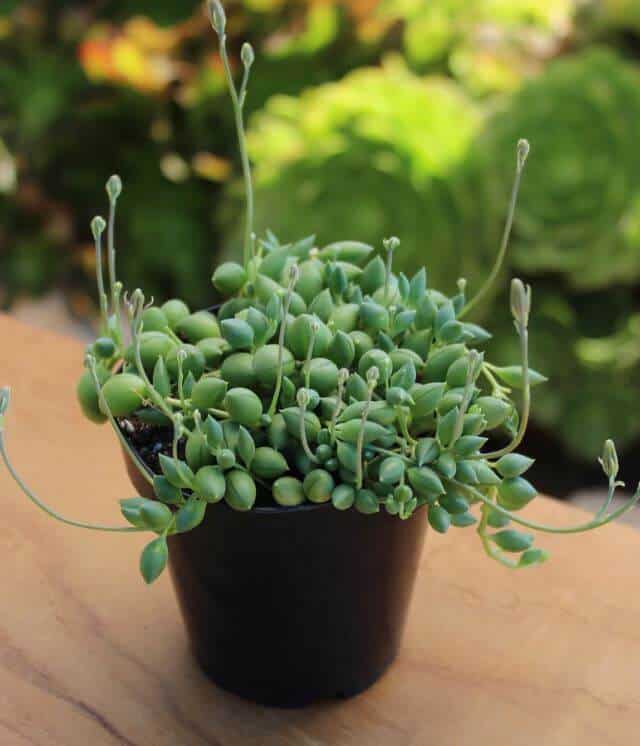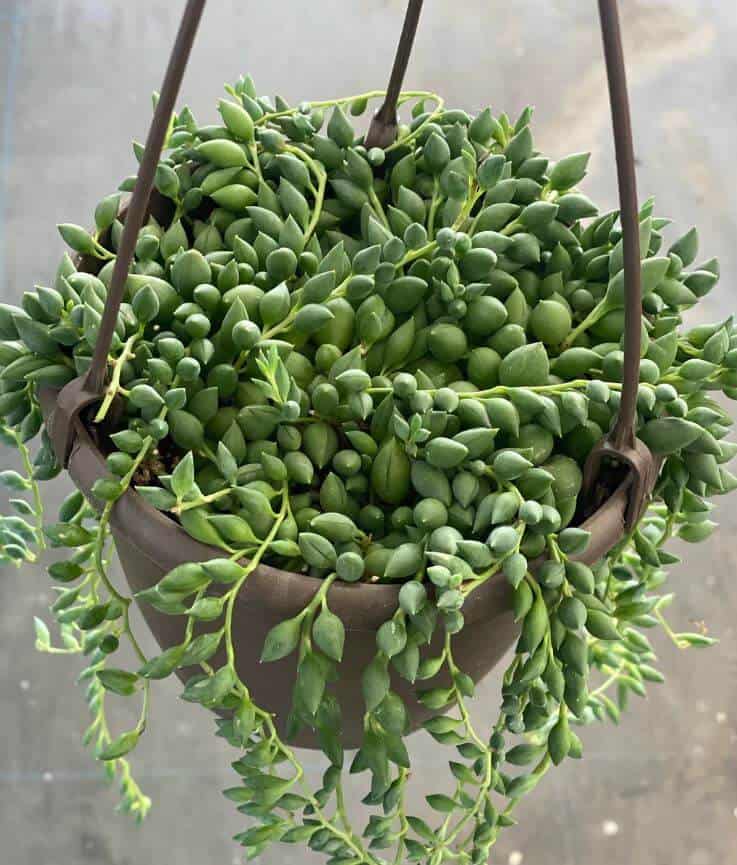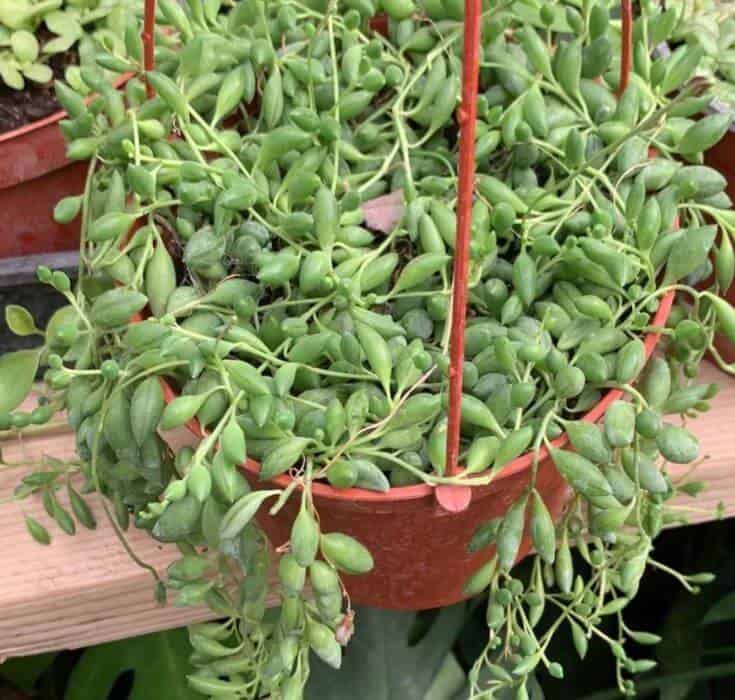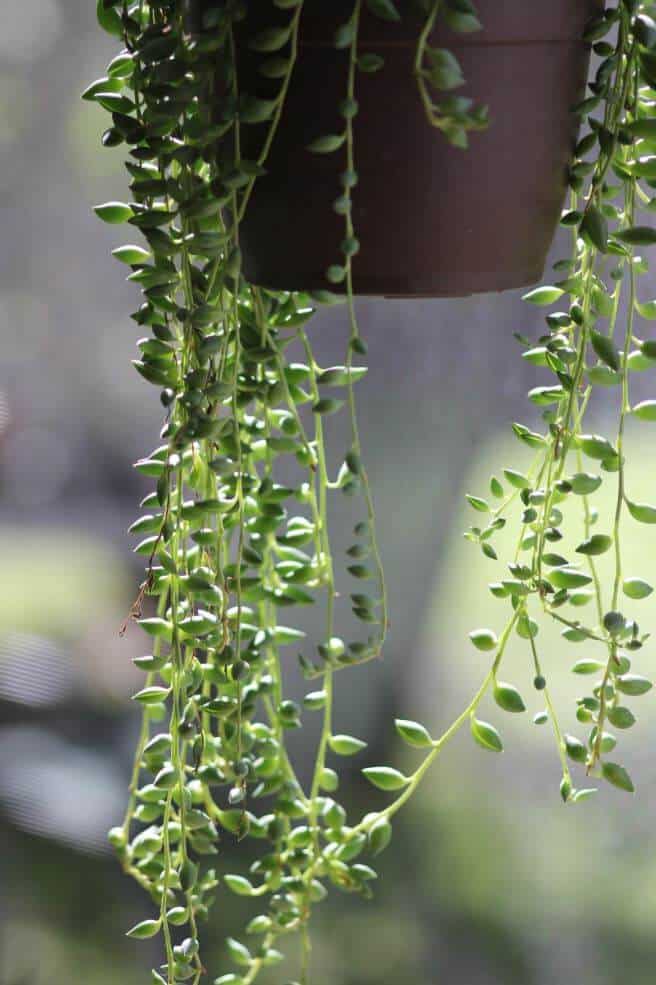Last Updated on September 9, 2023 by a Friendly Gardener
The String of Raindrops plant is a succulent characterized by long trailing vines with rounded leaves. The teardrop-shaped, bead-like leaves decorate slender stems that can grow to three feet in length, so they are best cultivated in hanging baskets or from high perches. They were originally identified as belonging to the Senecio genus, but have since been reclassified as Curio, so it’s easy to find the same plant under either name.
Considered a hybrid of the String of Pearls plant (Senecio or Curio rowleyanus), the String of Raindrops belongs to the Asteraceae plant family. It is closely related to the String of Bananas plant (Senecio or Curio radicans) and is a perennial that can be cultivated both indoors and outside. The String of Raindrops is a South African native botanically named the Senecio or Curio herreianus. Its name honors succulent expert and botanist Hans Herre. Other popular names include:
- String of Watermelons
- String of Beads
- Gooseberry plant
- String of Tears.
Foliage bear markings like those of a watermelon rind, explaining why one of the popular names is String of Watermelons. If the String of Raindrops foliage is crushed, it has a distinct sandalwood fragrance.
The String of Raindrops Plant Care

The String of Raindrops plant shares similar care requirements as other members of the Senecio or Curia genus. This is an adaptable plant tolerating drought and an ample environmental temperature range.
Soil

As a succulent this plant needs loose, well-draining soil. Choose a potting soil that is porous and specifically formulated for succulents. You can also blend a growing medium by using two parts potting soil, two parts coarse sand, and one part pumice or perlite. The pumice or perlite is included to guarantee drainage and aeration. Succulents can thrive with a soil pH range of 4 and 6.5, but 5.5 is ideal.
These species have shallow root balls, so the container should be shallow also. For extra protection use pebbles or gravel in the bottom of the pot to ensure good drainage and aeration.
Light
The String of Raindrops plants prefers partial shade as direct sunlight may scorch foliage, however, too little light with slow the plant’s growth habit. When cultivating this succulent indoors, it should receive at least three hours of light daily, but it should be indirect.
Water

The String of Raindrops has typical succulent foliage, so it stores water. Leaves are juicy and will tolerate drought. Succulents do not require much watering and should not be left to sit in soggy soil. The soil bed should be left to dry out before you water again. Avoid giving your plant large quantities of water, and water slowly. Leaves can also be misted.
Humidity
The Curio herreianus will do fine in average household humidity. It does not do well in environments with high humidity.
Temperature
The String of Raindrops hybrid will thrive in a temperature range between 68° and 82°F. so indoor temperatures should be fine. It needs warmth and should be placed in a heated location during the winter. If temperatures are very low or very high, the plant’s growth will slow as the plant may enter dormancy. Succulents will suffer damage when left in the cold. It can be cultivated outdoors in USDA hardiness zones 9b through 11b.
Feeding
Feed your Curio herreianus once annually during the summertime preferably with a liquid fertilizer for succulents that should be diluted.
Pruning
To maintain your plant’s shape, regular pruning is recommended for most vining plants. Stem cuttings can then be used for propagation.
String of Raindrops Propagation

These succulents are easy to propagate. In their native habitats, they will grow along the ground establishing roots as they elongate to create dense mats of succulent foliage. Stem cuttings can be trimmed year-round and then placed in fresh soil or lain across it. With good soil contact, the vine will form new roots.
String of Raindrops Problems
A hardy, resistant plant, the String of Raindrops’ greatest threat comes from overwatering as both root rot and stem rot can develop. Overwatering also leaves this plant weakened and susceptible to mealybug infestations. Mealybugs, which appear as cottony deposits should be removed, and the plant should be treated with insecticidal soap.
If rot sets in, take whatever healthy stem cuttings are left and begin again with a sterilized container and fresh potting mix.
String of Raindrops Toxicity
While the Senecio hybrid raindrops are not known to be poisonous, be aware that several related varieties of these succulents are known to be toxic. Hence, t is better to err on the side of safety and keep this plant out of the reach of family fur babies and small, unsupervised children.
String of Raindrops vs. String of Tears

It is generally the shape of foliage that defines these plants and their popular names. The “String of” plants generally store water in leaves and are vining plants. The String of Raindrops and String of Tears are closely related, belonging to the Daisy family.
The String of Tears (Senecio or Curio citriformis) is a slow-growing South African native with small tear-shaped or spindle-shaped foliage. Each leaf has a vertical upward-pointing tip. Foliage appears veined and waxy and feels sticky when touched. In its native habitat, the String of Tears grows low on the ground. Vines have nodes that produce roots, so this plant makes a wonderful ground cover. The String of Tears will flower producing small creamy yellowish blooms on wiry stems in the late summer to early winter.
The String of Raindrops (Senecio or Curio herreianus) Is also a South African native that is a flowering succulent. Foliage is a deep dark green featuring purplish stripes. While it does resemble other “String of “ succulents, its leaves are generally a bit longer and larger. When exposed to ample bright light, its purple hues may deepen. Flowers are tubular thanks to petals that create a base for the bloom’s anthers.
Both these Senecio varieties need the same care considerations to thrive. The foliage of both varieties resembles peas somewhat in shape, but the String of Tears has tapered leaves at the tip explaining the popular “teardrop” name. The two plants grow naturally in dry habitats and have adapted to drought conditions. Both species also have a type of translucent space or window that runs the entire leaf length. These spaces seem to facilitate photosynthesis while protecting foliage from overheating and damage.

